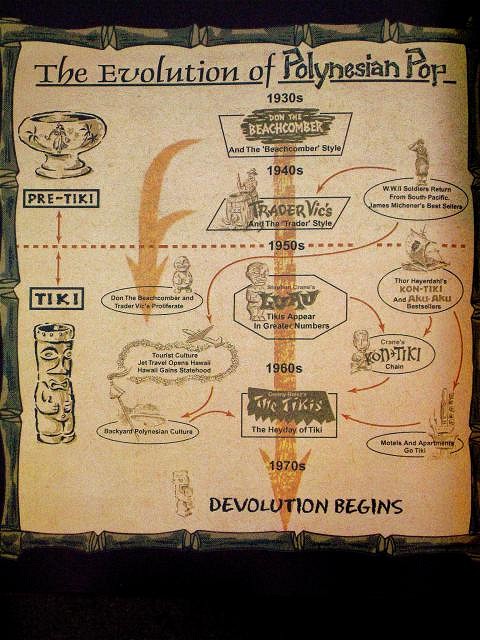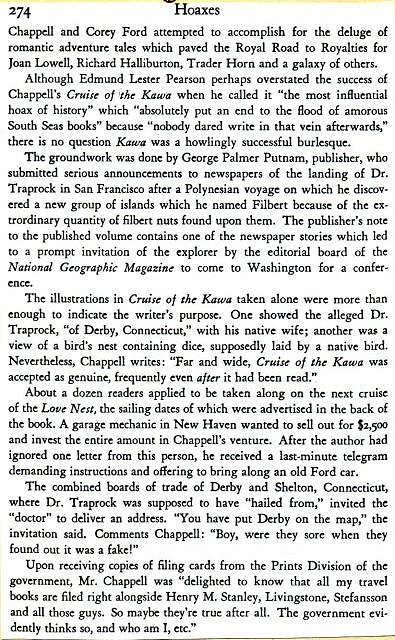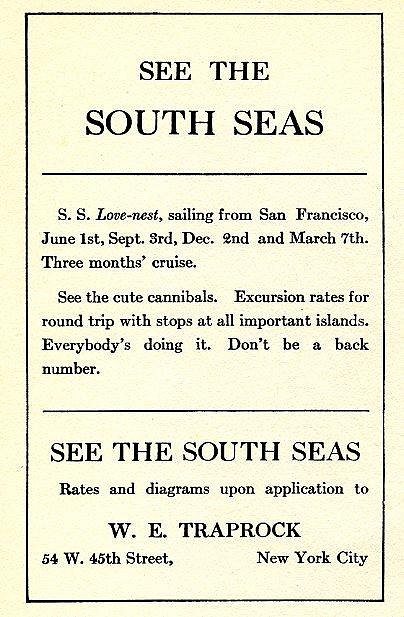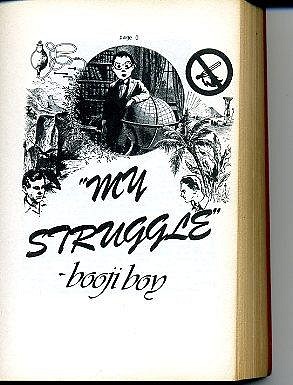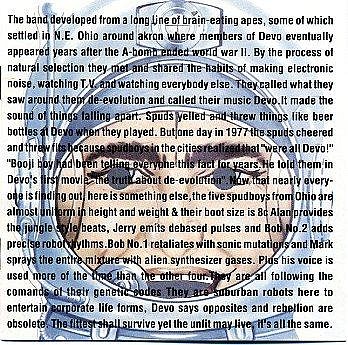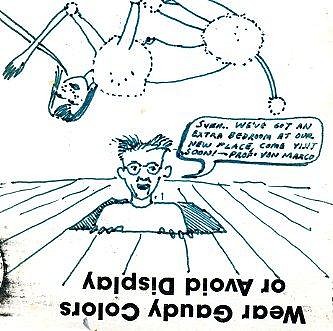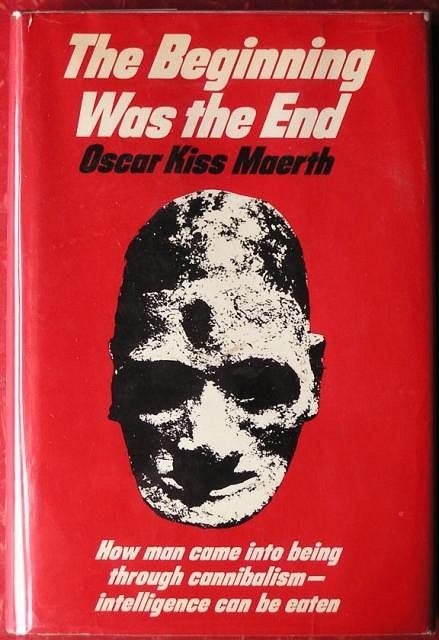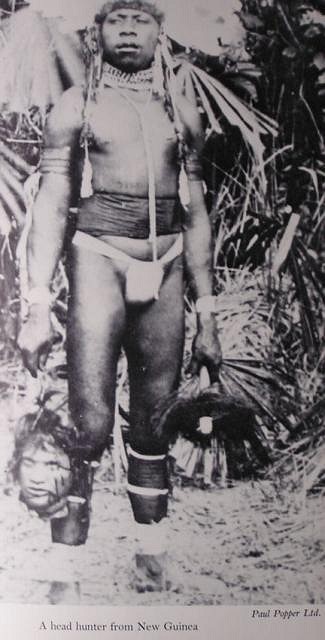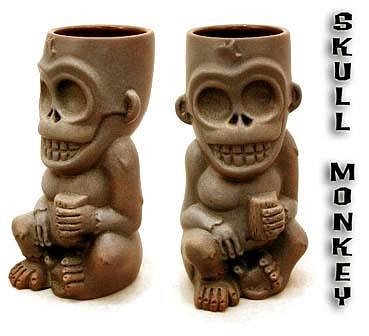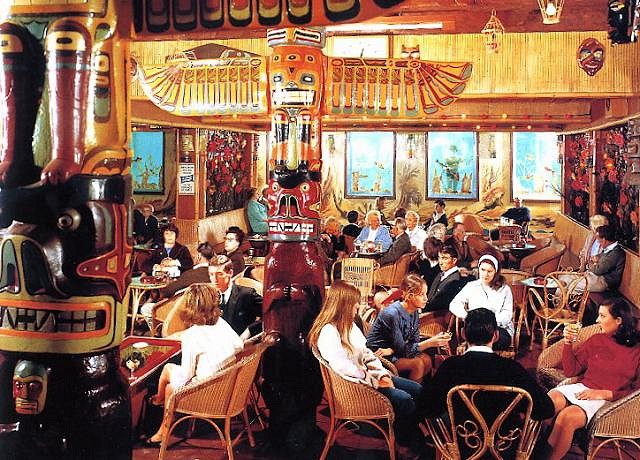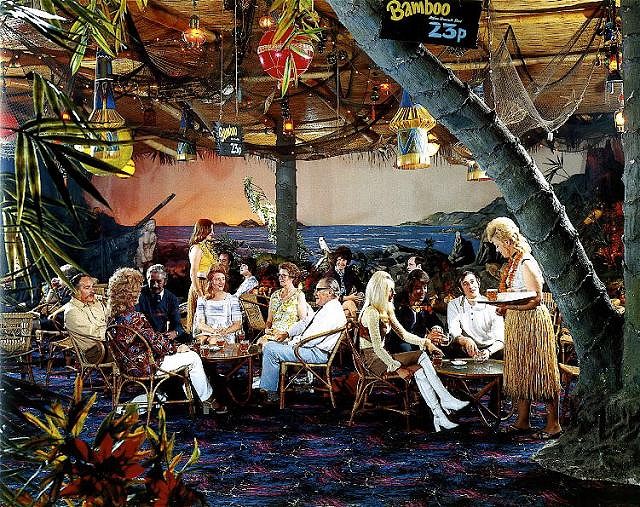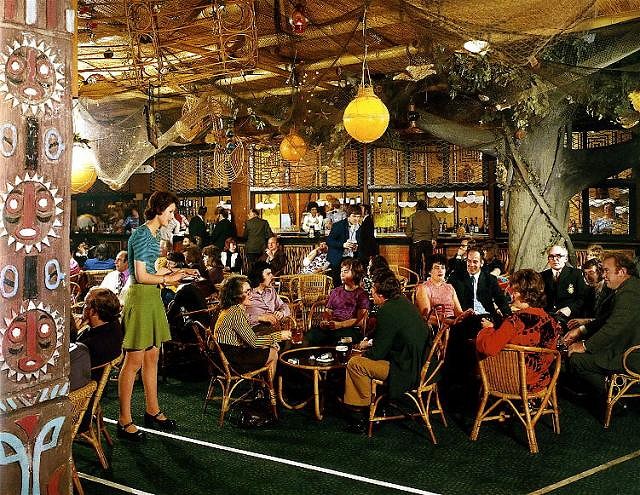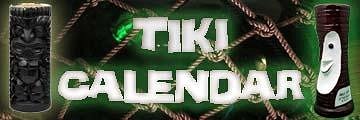Pages: 1 45 replies
|
M
MrBaliHai
Posted
posted
on
Sun, Apr 8, 2007 6:32 AM
I went digging through the magazine racks at our local antique mall yesterday, and emerged with the April, 1935 issue of Ballyhoo, a humor magazine published by Dell between the years of 1931 and 1939. This particular issue features a South Seas theme, which should be abundantly obvious from the glorious hula girl on the cover (is that Bob Hope strumming the uke and leering from underneath his straw boater?). The contents are a mixture of Playboy-style vintage adult cartoons and Mad Magazine-ish satire. I'm sure this was pretty sophisticated and edgy stuff back in the Thirties, but today it seems hopelessly quaint. No tikis or tropical cocktails, as this pre-dates the PolyPop era, but plenty of grass skirts, ukuleles, and National Geographic nudity. Here are a few sample images. You can view the full-page scans here.
|
|
JC
Jeff Central
Posted
posted
on
Sun, Apr 8, 2007 8:40 AM
Nice pictures BaliHai!! Thanks for posting. I need a cocktail shaker like THAT!!! |
|
B
bigbrotiki
Posted
posted
on
Sun, Apr 8, 2007 9:58 AM
Here you go, Jeff!
What a great find, that magazine, never saw it before! |
|
M
MrBaliHai
Posted
posted
on
Sun, Apr 8, 2007 10:08 AM
Duly noted, bigbro. I'd always assumed the PolyPop era started with Don the Beachcomber and whatever came before that was called, The Golden Age of Ukulelia, or something. |
|
T

tikibars
Posted
posted
on
Sun, Apr 8, 2007 10:43 AM
Thanks for sharing this stuff. This cartoon is so prophetic - as soon as I glanced at it I thought - modern Honolulu! So true. |
|
H
Haole'akamai
Posted
posted
on
Sun, Apr 8, 2007 12:20 PM
Yep - This is great!! Very interesting that they gave the ladies slanted almond-shaped eyes - to make them appear more" exotic? |
|
B
bigbrotiki
Posted
posted
on
Sun, Apr 8, 2007 12:29 PM
Basically, Polynesian pop started as soon as the the first explorers brought back their travelogues from the islands and embellished and romanticized them, inspiring further tall tales of earthly paradise that were the foundation of the cliched iconography that persists 'til today. Even Kevin Kostner's recent Rapa Nui movie can be considered Polynesian Pop. No matter how hard one tries to be authentic, if it is entertainment, and seen through western filters, it is pop.
You are correct, Sir: The era that concerns us here most starts with the Hawaiian music craze and the first Hawaiian nightclubs in the 1920s on the mainland, or, even more specifically with Don The Beachcomber in 1934. Then in the 1950s, Tiki became Poly Pop's figurehead. It's all explained in my Poly Pop Evolution chart on P. 46 of the BOT, here it is again for non-BOT holders:
|
|
M
MrBaliHai
Posted
posted
on
Sun, Apr 8, 2007 12:57 PM
The prescience of that cartoon surprised me as well. I wouldn't have thought that over-development in the islands was even an issue in 1935. |
|
M
MrBaliHai
Posted
posted
on
Sun, Apr 8, 2007 1:35 PM
I agree, but that's a very broad swath of time you're delineating. I can find examples of romantic south-seas imagery going back well into the 19th-century, like this 1873 lithograph from Harper's Weekly of half-naked savages dancing around highly-stylized Moai, and I'm sure there's imagery going back even farther, that also made it into the mass-media of its day. So even though its technically correct, the term "Polynesian pop" seems a bit too modern to me to really describe what filtered into the public consciousness in the pre-Beachcomber era. I guess I'd prefer something more evocative of those times. Your mileage may vary, of course. |
|
B
bigbrotiki
Posted
posted
on
Sun, Apr 8, 2007 4:09 PM
I was, of course, speaking figuratively, to explain the concept of the term, and then really agreeing with your asessment, showing the evolution chart that defined the term. |
|
M
MrBaliHai
Posted
posted
on
Sun, Apr 8, 2007 4:18 PM
No problem. You're certainly entitled to pontificate on your own theories...:) I'd just like to come up with something a little snappier than the "pre-tiki Polynesian Pop era"...howzabout"Steamtiki"? |
|
H
Humuhumu
Posted
posted
on
Sun, Apr 8, 2007 5:12 PM
Awesome find, Mr. Bali Hai, thanks so much for taking the time to scan in the whole thing! I personally tend to refer to that era as the "bamboo" era. It most often comes up for me when people ask about Tradr Sam's here in SF, which is not really a tiki bar, but ia a pre-tiki bar -- a bamboo bar. Tradr Sam's is actually probably full of rattan and not bamboo now that I think about it, but when I think of all those great, gorgeous tropical jazz bars that were in Hollywood and Chicago in the '30s, I think of clean lines and bamboo. |
|
M
MrBaliHai
Posted
posted
on
Sun, Apr 8, 2007 5:38 PM
My pleasure. I just scanned all of the South Seas-related material. There are actually about 10 more pages of generic cartoons that I didn't think would be of much interest here.
Yes, that certainly works for jazz-era nightclubs and bars like the Cocoanut Grove and the Hawaiian Room. With "Steamtiki", I was thinking more of how Polynesiana influenced the Victorian era, since I have a fair amount of ephemera from that time period. If I was more of an illustrator, I could up with some fun concept art of a Victorian tiki bar. |
|
H
Humuhumu
Posted
posted
on
Sun, Apr 8, 2007 5:54 PM
Is there a thread on Tiki Central for everything? What you've got may not perfectly fit the bill of what that thread is talking about, but it'd be interesting to see! I think Steamtiki is a 'fecto name for Victorian tropical stuffs. |
|
M
MrBaliHai
Posted
posted
on
Sun, Apr 8, 2007 6:42 PM
Heh. Why am I not surprised?...:)
Unfortunately, that thread never really coalesces around a single idea, but somehow combining The League of Extraordinary Gentlemen (comic book version, not the excremental film) with Trader Vic's is probably close to what I'm getting at. The problem you'd have to deal with in mixing Tiki and Victorian styles is that the Victorians viewed Polynesia as an inferior culture that they had a manifest destiny to conquer, Christianize, and replace with their own, which is almost the total opposite of mid-century Polynesian pop. One of the most heartbreaking images I have is this 1881 litho of 4 proud, beautiful Tahitian girls covered from head-to-toe in Victorian missionary garb. I think that sums the Victorian attitude towards Polynesia up very neatly. Bringing the conversation back to Ballyhoo, it shows just how much that puritanical view had changed by the Thirties. |
|
B
bigbrotiki
Posted
posted
on
Sun, Apr 8, 2007 6:58 PM
The humor of "Ballyhoo" reminds me of the 1921 book "Cruise of the Kawa" (see BOT P.33 for images, P.34 for text), the first spoof of South Sea lore. The article below describes how it was often taken seriously at the time:
This seems hard to believe, considering some of the photos... ...and the text Here's the ad that got several serious replies: I LOVE this kind of stuff! |
|
M
MrBaliHai
Posted
posted
on
Sun, Apr 8, 2007 7:45 PM
Now that's just astonishing. The fact that people actually bought into such a patently ridiculous storyline is almost frightening. I mean c'mon, A-E-I-O-U?!!! |
|
H
Humuhumu
Posted
posted
on
Sun, Apr 8, 2007 10:09 PM
I'd never thought of it in those terms, but this really sums up why I prefer the later, tiki era of Poly Pop -- there seems to be more real reverence for Polynesia (even if most still had no idea what Polynesia really was like), and an interest in joining them, rather than beating them. Not always, of course -- you still come across stuff from the '50s and '60s that indicates a lack of respect, and the gender inequalities of the day crop up regularly, plus you have to question whether it's really respectful to totally misrepresent a culture -- but there seems to have been a growing general attitude of "hey, they've really got something figured out in the South Pacific" during the '40s, '50s and '60s, vs. this "those savages are so simple and funny!" Even though I don't like this earlier stuff as much, and don't feel as drawn to it, I still find it fascinating in the context of mainland fascination with Polynesia. |
|
K
Koolau
Posted
posted
on
Mon, Apr 9, 2007 1:38 AM
Even though Sven's mentioned it a million times, that magazine really drove home the idea of "pre-Tiki". There's not one tiki in any of the illustrations - just grass huts and hula girls. I'm still amazed. I have to re-read the Book of Tiki - why did tiki become the central image of Poly Pop? |
|
M
MrBaliHai
Posted
posted
on
Mon, Apr 9, 2007 4:34 AM
I'd be interested to hear bigbro's pet theories on that one...:) This issue of Ballyhoo was clearly focused on leering at, and fooling around with native women. Hardly surprising for a men's mag. If you look at other publications from this era, the focus shifts slightly to "romance" and island music. |
|
P

PockyTiki
Posted
posted
on
Mon, Apr 9, 2007 8:55 AM
On the first page with the image of the chart, at the bottom of that chart is says that "Devolution Begins". My question is, "What is Devolution?" is it like the time that poly-pop and tiki sort of went down the toilet? I'm slightly in the fog. :( |
|
S
Swanky
Posted
posted
on
Mon, Apr 9, 2007 10:28 AM
There were tons of tropical restaurants before Donn Beach. No telling to what extent he borrowed from them. The era of the Lurline cruises to Hawaii really got the imagery of Hawaii romanticized for everyone more and more. The Hula girl was the icon of the pre-Donn era. Hula girls and monkeys. And now there are more and more places called "tiki bars" which are just tropical. It's a generic term now. Almost weird. How many people here in East TN have ever been to a real tiki bar, and yet, Target is selling "Tiki Bar" signs to them. And I bet they drink Corona under them. That's De-volution of Tiki. |
|
B
bigbrotiki
Posted
posted
on
Mon, Apr 9, 2007 11:26 AM
Well you had to ask....:) "being in the fog" could be a symptom of Devolution!
1969-- Philosopher Oscar Kiss Maerth publishes "The Beginning Was The End", his theory of the fact that human E-volution is actually a DE-volution: Once the prehistoric ape species started eating meat, especially each others brains, their own brains mutated into the human brain, and "intelligence" evolved. In the course of that, man lost all his natural abilities for telepathy and instinctual understanding, and man's brains today are actually sick mutations of a once natural state of consciousness in balance with nature, and thus are destined to destroy themselves (see global warming thread). http://en.wikipedia.org/wiki/Oscar_Kiss_Maerth 1971-- Mark Mothersbaugh writes "My Struggle"under the pseudonym of Booji Boy, an "art" book predating the Subgenius Church religious tract aesthetic:
When he and his friend Jerry Casale come upon Oscar Kiss Maerth's Devolution theory, the basic concepts of DEVO solidify:
1977-- David Bowie announces DEVO as the band of the future.....(the beginning of the end?) 1982--After a brief stint at the San Francisco Art Institute, Sven Kirsten moves down to Los Angeles, taking up his friend Annerose's boyfriend's (Mark Mothersbaugh) offer to stay at his house while looking for a place to live. Oceanic tribes knew about the mana contained in their trophy heads. Perhaps we re-enact the eternal sin that began devolution by drinking from our Tiki mugs....dancing on the volcano. Tiki could actually be seen as a form of devolution: The desire to return to the beginnings of man, to the primitive state, and be free of the "Freedom of Choice" that puts us into a "fog". :) |
|
T

tikibars
Posted
posted
on
Mon, Apr 9, 2007 11:49 AM
I knew it - sooner or later, someone had to tie together Devo and Tiki... Nice one, Sven. "Freedom of choice - is what you got.
|
|
H
hawaiiansnowball
Posted
posted
on
Mon, Apr 9, 2007 11:58 AM
The Ballyhoo's South Sea's Guide is a pretty amusing read... great stuff! |
|
I
ikitnrev
Posted
posted
on
Mon, Apr 9, 2007 12:37 PM
I think we can also add the band Cramps and Munktiki to this devolution theory. Reading the Wikipedia entry for Oscar Kiss Maerth, I learned that the band DEVO referred to him as 'Author Kiss-My-Ass' I immediately thought of the Cramps song 'Kizmiaz' which can be found on their 'A Date With Elvis' CD. This song is perhaps the most tropical/exotic song that the Cramps ever recorded. Take a magic carpet to the olden days Flamingos stand easy on bended knees Now consider that Sven was the cinematographer for the Cramps music video 'Bikini Girls With Machine Guns.' We have direct links between Sven, tiki, Devo, and the Cramps. It is all making sense! And we can even throw in the people at Munktiki, with the creation of their Skull Monkey Mug.
Learning about Oscar Maerth's theories has provided me with new meanings for this mug. I used to think of this as just a simple monkey mug - but now I think of it as the perfect mug to designate that moment when monkeys first started to eat their brains, marking the point in time when devolution started. I've just ordered the Oscar Maerth book, and soon expect my horizons to be further broadened. Vern |
|
B
bigbrotiki
Posted
posted
on
Mon, Apr 9, 2007 12:42 PM
...but back to the PRE-TIKI to TIKI style evolution: Early 20th Century Polynesian pop drew its image vocabulary from a slew of South Sea icons: The palm tree, the native hut, the outrigger, the tropical flowers, the ukulele, and most prominently, the Hula Girl. Primitive art in the form of Tikis also surfaced sometimes, but very rarely. One of the most convincing, uncanny examples for that evolution can be found in my Trader Vic chapter in the BOT. The Trader's first bar guide, and all his menu covers before and during WWII wallow in the typical South Seas iconography mentioned above (his classic 1947 menu is known to everyone), and not until the late 50s does the Tiki become more prominent in Trader Vic's graphics and, in his mug and glassware. Though both, Don The Beachcomber and Trader Vic, because their aesthetic was rooted in the Pre-Tiki period, never went as full-tilt Tiki as for example the Luau/ Kon-Tiki chain, and other, 1950s/60s Tiki establishments. I still believe Tiki Bob's was the first place to use the Tiki as a logo, together with the Luau in Beverly Hills, who introduced its Tikis in its menu text. Why? There is a nice German term for it, "Zeitgeist", or "spirit of the times". In my upcoming tome "Tiki Modern" I am elaborating on how not until after WWII the avantgarde's appreciation for "primitive art" reached the middle class, making it de rigeur to have a piece of African or Oceanic sculpture in your otherwise modern home. The Tiki's appreciation paralelled that development in recreational pop culture. The Tiki gave Polynesian pop an edge, providing the darker side of paradise, which in pre-Tiki times had sometimes been occupied by the figure of the Zombie. I also see a paralell to the monster aesthetic of Movie Monsters like Frankenstein, and the creations of Big Daddy Roth. Why did they become "cool" at the same time than the Tiki, around the late 50s/early 60s? There simply was a need for something edgier, weirder than the usual Ken and Barbie stuff. Also in the 50s, the popularity of Thor Heyerdahl's Kon-Tiki undoubtedly led to the term becoming better known, and helping Tiki to take its prominent place in the Poly pop theater. As I said before, in its heyday, the term "Tiki style" did not exist, but occasionally people the time referred to Polynesian style as "Kon-Tiki style." A Zeitgeist is always a result of multiple influences, and so the question of WHY Tiki became Polynesian Pop's figurehead in the 50s/60s is complex. Any other suggestions are welcome. |
|
I
ikitnrev
Posted
posted
on
Mon, Apr 9, 2007 1:39 PM
There may be another factor involved. Most of us are familiar with the similarities between the tiki of the Hawaii/South Pacific vein (and Hawaii becoming a state in 1959), and the totem pole of Alaska/North Pacific (and Alaska becoming a state in 1958) I agree with Sven's observation, that the 1950's were a period of cultural zeitgeist. With both Alaska and Hawaii becoming states, the average American were open to welcoming the cultures of the new states into the U.S. For the average citizen, it might have been easier to accept both the tiki and the totem poles as new cultural icons - a form of 'two heads are better than one' - meaning that the presence and reemergence of both icons at the same time helped each to become more engrained in the collective U.S. culture. I looked at the Wikipedia entry for 'totem pole', and learned that the totem pole did receive a revival in the 1950's ... and confirms the theory of the zeitgeist. "Totem pole construction underwent a dramatic decline at the end of the 19th century due to American and Canadian urges towards Euro-American enculturation and assimilation. Fortunately, in the mid-twentieth century a combination of cultural, linguistic, and artistic revival along with intense scholarly scrutiny and the continuing fascination and and support of an educated and empathetic public led to a renewal and extension of this moribund artistic tradition."I couldn't resist adding the following text, also from the Wikipedia totem pole entry. It brings to me more similarities between tiki and totem pole, and the theory of devolution. After reading this, I wonder if Basement Kahuna might have a twin brother, living in Alaska and trying hard to preserve the original totem styles. " The appropriation by art and tourist trinket worlds of Northwest Coast American culture has resulted in, among other things, an inundation of cheap imitations of totem poles executed with little or no knowledge of the complex stylistic conventions demanded by Northwest Coast art. This proliferation of "totem junk" has diluted the public interest and respect for the artistic skill and deep cultural knowledge required to produce a pole."Vern |
|
B
bigbrotiki
Posted
posted
on
Mon, Apr 9, 2007 2:23 PM
Hmmm...yes, that goes along with the generally raised awareness for primitive art, which also included pre-Columbian art. There actually is one hilarious example of the intermingling of Totem pole and Tiki, committed by a confused (or lazy) architect in England: Butlin's Holiday Camp in Clacton had this decor to offer in their "South Seas Bar":
Also interesting is that William Westenhaver at one point taught North Pacific Coast Indians how to chainsaw-carve totem poles. He also decorated a "kachina" doll style bar up North in the 60s. Thanks for those added photos, James! One more delineation to my Tiki-period theory is that Tiki style was predominantly a MAINLAND phenomenon. In Hawaii, the cultural sensitivity was too great to mess with the ancestor images, and in the rare cases that they were employed for commercial reasons, they were kept painfully close to the originals. All evidence of Tiki style IN the islands was actually re-imported from the mainland (Don/Vic/Kon-Tiki, Barney West and O.A. Tikis). So even in the 50s and 60s, any Hawaiian based Polynesian icon production concentrated on the early Pre-Tiki Polynesian pop catalogue mentioned above (...except Coco Joe's and Hip), and cranked out what is known as Hawaiiana, which I find lacking the edge that Tiki style has. |
|
H
Humuhumu
Posted
posted
on
Mon, Apr 9, 2007 2:33 PM
Oh my god, that is too funny! Here's another image I found from the same bar:
I'm familiar with Butlin's Beachcomber bars, but not their South Seas bars -- do you know if there were any others, and if they were as off-base as this? |
|
B
bigbrotiki
Posted
posted
on
Mon, Apr 9, 2007 4:01 PM
No noooo, the others were MUCH MORE tasteful:
...although the wait staff apparently did not always don the obligatory native garb:
The above are both Beachcomber Bars, in Skegness and in lovely Minehead (?), and I believe that since they were modeled after the Mayfair London Beachcomber, the South Seas name was an exception....maybe they thought that totem poles would not fly as beach-combed flotsam, but would pass as some kind of unknown South Seas idols? |
|
M
MrBaliHai
Posted
posted
on
Mon, Apr 9, 2007 4:07 PM
Egad! If we can just calculate their Bacon Numbers, the Grand Unified Tiki Theory (GUTT) may finally be within our grasp! |
|
JC
Jeff Central
Posted
posted
on
Mon, Apr 9, 2007 4:08 PM
That carpeting in the first picture looks like REAL water!! I like the girl in the go-go boots too!! :wink: Very Cool!!! Cheers and Mahalo, |
|
B
bigbrotiki
Posted
posted
on
Mon, Apr 9, 2007 4:16 PM
Weeell, son, there you go: |
|
M
MrBaliHai
Posted
posted
on
Mon, Apr 9, 2007 4:20 PM
That's very reminiscent of the decor of the Thunderbird Hotel's Pow-Wow Lounge in Minneapolis. Of course, they don't claim any connection with tiki. |
|
M
MrBaliHai
Posted
posted
on
Mon, Apr 9, 2007 4:38 PM
Mark Mothersbaugh and Lux Interior both have a Bacon number of 3, while you are even closer to the divine aroma of Baconality with a '2'. "Tiki", however, returns a Bacon number of infinity, but I suspect that's simply due to the Oracle of Bacon's inability to parse anything outside of the film and television industry. Zeroing in on entertainment personalities closely associated with Polynesian Pop produces better results: Martin Denny, for example, has a Bacon number of 3, and Edd "Kookie" Byrnes comes in at 2. It's so tantalizingly close. I can almost sense the impending collapse of the holistic quantum tiki probability wavefront into a shining singularity of white-hot reality!
[ Edited by: MrBaliHai 2007-04-09 16:50 ] |
|
P
PremEx
Posted
posted
on
Mon, Apr 9, 2007 11:45 PM
From a simple mind...a possible simple addition to the pot: Tiki is fun to say. There's just something about it. And it can be gagged up all sorts of way. I can just picture my dad at say the Kon-Tiki in the 1960's getting up from his table and announcing, "I gotta go take a tiki-leaky." Nyuck, nyuck. Even Disney's highly sing-alongable "In the tiki, tiki, tiki, tiki, tiki room...in the tiki, tiki, tiki, tiki, tiki room"...suggests that Walt (or the Sherman Brothers) knew we just couldn't seem to get enough of saying, "Tiki!" Heck...we called those Molotov cocktails on sticks "Tiki Torches" even though they were no more than cocktail shakers with a wick stuck in them. Oh sure...they might have at some point been designed to illuminate tikis. But really...they got the name because it's just fun to say, "Let's light the Tiki Torches!" I think people just loved saying "Tiki." Still do. That's why you got Tiki Bars with no tikis in sight. "Hey! It's a TIKI bar! I'll have a margarita, please." Just a thought. Don't make fun of me, or I'll tweaky your tiki. :wink: |
|
B
bigbrotiki
Posted
posted
on
Tue, Apr 10, 2007 9:18 PM
But why! Wouldn't dream of it, because...this is another excuse for me to bring out another pet theory: In the early 90s, Linguist Merrit Ruhlen traced back all human language to the first word, and the first word supposedly ever uttered by man was "TIK" (which meant "finger","the one", and...well you know): "Just as archaeologists study fossils and ancient artifacts for clues about mankind's origins, linguistic researchers today are sifting through word roots and grammatical conventions and coming up with some startling revelations about our beginnings. In 'The Origin of Language' noted linguist Merritt Ruhlen takes you on a fascinating journey of discovery back through nearly 100,000 years of human history and prehistory in pursuit of the language from which all modern tongues derive..." Of course, there are always academic sticklers who want to spoil the fun :( : "Ruhlen is an controversial figure in the linguistics community due to his vocal support of the Proto World Hypothesis.... Most mainstream historical linguists reject Ruhlen's assumptions and methodology, holding that it is impossible reconstruct a language spoken at least 30,000 years ago, possibly more than 100,000 years ago." Weeell...says who? :) "..Ruhlen discusses the exciting new work being done in genetics and archaeology that corroborates much of the controversial linguistic evidence. But more than simply describing his and his colleague's theories, Dr. Ruhlen invites you to share in the joys of discovery..." To me, this is what it is all about: The joy I get out of unusual, new CONCEPTS, be they scientifically sound or not. THAT is what made another kooky theory, Thor Heyerdahl's KON-TIKI, so popular, inspite of it being derided by all the other migration scholars.(and the fact that he turned theory into practice!) Ruhlen's theory prooves the archetypal power of the term TIKI---the one---first man---the origin of art--- ...but, WHY this buzzword hit home especially beginning in the 1950s is still not quite answered with that realization. |
|
R
RevBambooBen
Posted
posted
on
Tue, Apr 10, 2007 9:47 PM
Eli or Ely ??? Arrrrr!!!! LOL!!! |
|
UB
Unga Bunga
Posted
posted
on
Tue, Apr 10, 2007 10:34 PM
|
|
T

tikibars
Posted
posted
on
Tue, Apr 10, 2007 10:52 PM
From a book that I hope you'll all be reading this summer: "Beachcomber Bar, Butlin’s Holiday Camp (six locations), UK Butlin's is a chain of nine resorts in England. During the 1960s and 1970s, at least six of them (Bognor Regis, Minehead, Ayr, Barry Island, Skegness, and Filey) had Beachcomber Bars. All of the Beachcomber Bars are gone now - though the resorts are still there - but extant photos show a surprisingly high TiPSY Factor, rivaling, in fact, many of the best North American bars of the era. It is said that Mr. Butlin got the idea for his Beachcomber Bars from the one in the Mayfair Hotel." |
|
S
Swanky
Posted
posted
on
Wed, Apr 11, 2007 6:12 AM
|
|
H
Humuhumu
Posted
posted
on
Wed, Apr 11, 2007 11:50 AM
Thanks, JT, but as I stated, I know plenty about the Butlin's Beachcomber bars, I was asking about any other Butlin's South Seas Bars. :) If the theme of the bar was "world trader" or "Pacific rim" the totem would make sense, but since the bar was named "South Seas Bar," there just ain't no excusing a Pacific Northwest totem as the dominant, central graphic element. Trust me, I lived there, and no matter how hard you will it (oh, how I tried), it just is not the South Seas. South Bering Sea, maybe. |
|
STCB

Sabu The Coconut Boy
Posted
posted
on
Fri, Apr 13, 2007 4:25 PM
Here's another postcard image from the Victorian era that will make you cringe as well: It was also probably looked upon quite favorably in the 19th century. Amazing that by the turn of the century, the South Pacific was gaining a different, romantic image in the minds of Westerners. I love your magazine. The cover especially is priceless in its imagery! Sabu |
|
J
JohnnyP
Posted
posted
on
Fri, Apr 13, 2007 5:16 PM
Could this have anything to do with the fact that James Cook traveled to, explored, collected artifacts, and graphically documented both the Pacific Northwest and the South Seas on the same voyages. The much published records of his trips containing both geographical locations must have been ready reference materials for those looking to recreate or give the illusion of an exotic location. These records of Cook's trips were well published and widely distributed long before Ralf Linton's "Arts of the South Seas" was. JP |
|
M
MrBaliHai
Posted
posted
on
Fri, Apr 13, 2007 6:25 PM
That's a very sad image indeed. To be sure, there were certain aspects of Polynesian culture that were better off being cast into the flames of history, but to destroy a people's artistic and religious culture is an unforgiveable sin.
Thanks. I think the cover captures the spirit of the times perfectly. |
Pages: 1 45 replies







